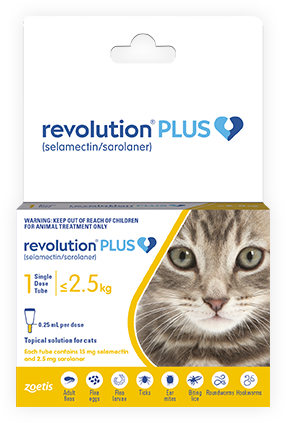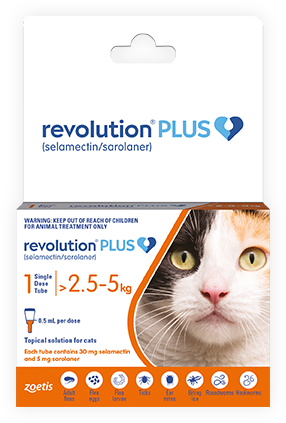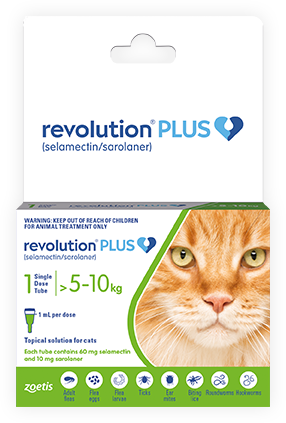
One small Revolution Plus dose from the handy pipette and you can say goodbye to fleas, flea eggs, flea larvae, ticks, mites, lice, hookworms and roundworms! For an entire month! It’s the dual action technology in Revolution Plus that’s strong enough to work fast, yet soft on your fur baby.
Revolution Plus products
Whether you’ve got a youngster or a big handful of fur, there’s a Revolution Plus monthly flea treatment purrrfect for your cat. Just choose the pack for your cat’s weight.

2.5mg Sarolaner
For cats: 1-2.5kg

5mg Sarolaner
For cats: 2.5-5kg

10mg Sarolaner
For cats: 5-10kg
Where to buy?
You can find Revolution Plus at all good vets and from your local pet store. Just ask.
How to apply
It’s so easy! Just squeeze the measured dose on your cat’s neck. No need to rub in.
It’s fast drying and the fleas won’t know what’s hit them.
STEP 01
Press cap until you hear a “CLICK”
Hold tube upright and press the cap to puncture the seal. Remove cap and make sure tip is open.
STEP 02
Part neck hair and squeeze tube
Part the fur at the base of your cat’s neck and touch tube tip to visible skin. Squeeze tube 3 or 4 times in one spot.
STEP 03
Glide tube, lift and discard
Keeping the tube squeezed, glide it along the skin and away from the liquid, then lift off. Ensure the tube is empty before throwing it out.
Treatment & Prevention Plan
Only 1 out of every 20 fleas affecting cats are found on their body. Where are all the others?
They're in and around your cat's living environments.
TREATMENT PLAN
There will already be fleas in your cat's living spaces, so this Flea Treatment Plan will help you get your house parasite-free as quickly as possible.
DOWNLOAD TREATMENT PLANPREVENTION PLAN
Now you’ve created a flea-free environment, use this flea prevention plan to ensure they don’t come back.
DOWNLOAD PREVENTION PLANFAQ
To keep your cat and home environments healthy, learn how to recognise the symptoms of parasites, as well as how to prevent and treat parasite infestations.
There’s no other way to put it - fleas are blood-sucking ectoparasites (that live on the skin surface of their ‘host’).
There are 2,200 flea species known in the world today. Only a few of these commonly infest cats.
The most common flea that affects cats is the cat flea, or Ctenocephalides felis. It’s dark brown or black body is about one to three millimetres long.
These troublesome pests are unpleasant for cats and owners.
Ear mites are highly contagious and pass easily from pet to pet. Otodectes cynotis, the ear mite of cats, accounts for 5 — 10 percent of otitis externa cases in cats. Otitis externa is an inflammation of the external ear, it results in frequent head shaking and pawing, an unpleasant odor, and discharge.
Ear mites are easily transmitted among animals and are spread by direct contact. These oval mites are fairly large and look like coffee grounds in the cat's ear. These troublesome pests do not burrow in the ear; rather, they live on the ear canal's inner surface.
Signs
- Ear infection
- Intense scratching or head shaking
- Red-brown or waxy ear discharge
- Itching skin around ears, head, neck
- Thick crust around outer ear
- Possible crust and scales on neck, rump, and tail
What You Can Do to Help
Your veterinarian can recommend preventive treatment such as Revolution Plus.
Monthly use of Revolution Plus treats and controls ear mite (O. cynotis) infestations in cats, and in kittens as young as 8 weeks.
Roundworms are one of the most common of the parasitic worms found inside a cat.
Roundworms live within the small intestine and migrates through the liver and lungs causing organ damage which can be severe if there are large numbers. They can also cause fatal infections in kittens.
A kitten may become infected with roundworm when it suckles its mother or by consuming roundworm eggs shed by another cat.
People can become infected by consuming roundworm eggs. This is more likely to happen to children who encounter a contaminated outdoor area, and get the sticky roundworm eggs on their clothes or toys, then their hands and, eventually, in their mouth.
Signs
- Vomiting
- Diarrhoea
- A pot-bellied appearance
- Abdominal discomfort
What You Can Do to Help
Prevention includes regular faecal exams, prompt disposal of cat faeces and the administration of a preventative medication like Revolution Plus.
A parasite is a plant or animal that lives on or inside another living organism (called a host).
A parasite is dependent on its host and obtains a benefit, such as survival, at the host’s expense.
There are two basic types:
- Internal parasites (endoparasites) such as roundworms that live inside the body of a host such as a cat.
- External parasites (ectoparasites) such as fleas, ticks, ear mites and biting lice that live on the body of their host such as a cat.
It depends on three things: the type of parasite, the degree of infection or infestation, and your pet’s individual reaction. A mild flea infestation may be of no great consequence to some cats, while others may show hair loss, itching and discomfort. Severe flea infestations can lead to significant skin disease, anaemia or even death, especially in young kittens. Infestations by ear mites can cause inflammation of the outer ear (i.e. ‘otitis’) that can be further complicated by secondary fungal and bacterial infections characterised by an unpleasant odour and a crusty brown discharge.
The 4 life cycle stages of a flea
- Are not sticky and once laid quickly fall off the cat into the surrounding environment
- Can't be readily seen with the naked eye
- Make up 50% of the flea lifecycle
- Take between 1-10 days to hatch into larvae
- Hatch from the flea eggs
- Are a small worm-like life form that move away from the light
- Bury themselves in dark places e.g. deep in carpet pile
- Last 5-11 days while they undergo 2 moults to become a pupa (cocoon)
- In a sticky impenetrable cocoon that becomes covered in debris
- Usually lasts 5-14 days, but may lay dormant for up to 6 months
- Are the ones you see jumping around your cat's coat
- Bite then feed on the blood of their host
- Make up 5% of the flea lifecycle







